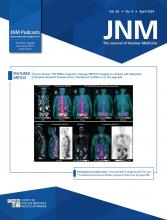Abstract
PET imaging with β-amyloid ligands is emerging as a molecular imaging technique targeting white matter integrity and demyelination. β-amyloid PET ligands such as “11C-Pittsburgh compound-B” (11C-PiB) have been considered for quantitative measurement of myelin content changes in multiple sclerosis (MS), but 11C-PiB is not commercially available given its short half-life. A “18F-PET” ligand such as flutemetamol with a longer half-life may be an alternative, but its ability to differentiate white matter hyperintensities (WMH) from normal appearing white matter (NAWM) and its relationship with age remains to be investigated. Methods: Cognitively unimpaired (CU) older and younger adults (N = 61) were recruited from the community responding to a study advertisement for β-amyloid PET. Participants prospectively underwent MRI, 11C-PiB and 18F-Flutemetamol PET scans. MRI-FLAIR images were segmented into WMH and NAWM and registered to the T1-weighted MRI. 11C-PiB and 18F-Flutemetamol PET images were also registered to the T1-weighted image MRI. 11C-PiB and 18F-Flutemetamol standard uptake value ratios (SUVrs) from the WMH and NAWM were calculated using cerebellar crus uptake as a reference for both 11C-PiB and 18F-Flutemetamol. Results: Median age was 38 years (range 30-48) in younger adults and 67 years (range 61-83) in older adults. WMH and NAWM SUVrs were higher with 18F-Flutemetamol than 11C-PiB both in older (p<0.001) and in younger (p<0.001) CU adults. 11C-PiB and 18F-Flutemetamol SUVrs were higher in older compared to younger CU adults in both WMH (p<0.001) and in NAWM (p<0.001). 11C-PiB and 18F-Flutemetamol SUVrs were higher in NAWM compared to WMH in both older (p<0.001) and in younger (p<0.001) CU adults. There was no apparent difference between 11C-PiB versus 18F-Flutemetamol SUVrs in differentiating WMH from NAWM in older and in younger adults. Conclusion: 11C-PiB and 18F-Flutemetamol show a similar topographical pattern of uptake in white matter with a similar association with age in WMH and NAWM. 11C-PiB and 18F-Flutemetamol can also effectively distinguish between WMH and NAWM. However, given its longer half-life, commercial availability, and higher binding potential, 18F-Flutemetamol can be an alternative to 11C-PiB in molecular imaging studies specifically targeting MS to evaluate white matter integrity.
- Neurology
- PET
- PET/CT
- PET
- Pittsburgh compound-B
- flutemetamol
- normal appearing white matter
- white matter hyperintensity
- Copyright © 2021 by the Society of Nuclear Medicine and Molecular Imaging, Inc.







